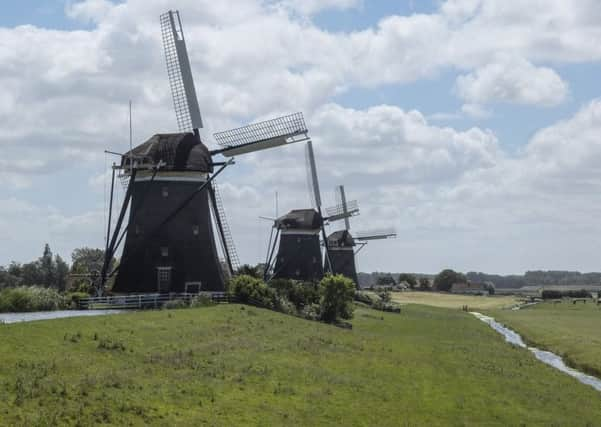Travel review: The Netherlands - an ideal place for a cycling trip


A list of famous Dutch people might include the likes of Rembrandt, Fanny Blankers-Koen and Cornelis Lely. You’ve heard of the first two but perhaps not of Cornelis. He was a civil engineer, Dutch minister for transport and water management and has a town named after him. All in all, he’s pretty well known in Holland for the work he led to contain the North Sea and create extra land for low-lying coastal areas from the seabed.
His designs included the 20-mile-long Afsluitdijk causeway, which separates the Wadden Sea to the west and IJsselmeer, protecting thousands of square miles of land. It was this causeway, on a very blustery day, that we crossed on our circular route of Holland. Three days of a head wind in this flat country had been debilitating, but once over the causeway we were heading south and the wind was behind us.
Advertisement
Hide AdAdvertisement
Hide AdHolland is the perfect place to dip your toe into the world of cycle touring. Cyclists have dedicated cycle paths to ride on, it’s mainly flat and you can go as fast or as slow as you want. We landed at the Hook of Holland from Harwich and after a good night’s sleep and a substantial breakfast, we disembarked to 40mph winds heading in our faces. The plan was to ride along the coast and cut east inland. Owing to the “breeze”, we chose to zigzag inland from the port, avoiding the strongest of the wind, ride through Amsterdam and arrive at the first night’s hotel a few miles north of the capital at around 6pm – after all, we had all day to do 64 miles. Our calculations were wrong. We arrived at 8pm after 82 miles and riding through Amsterdam at rush hour.
We were following a series of cycle paths and small roads that led north towards Amsterdam. We made progress past canals and over intersections, all catering for cyclists, to the Central Station in the city, from where we crossed the water to north Amsterdam on a free ferry, hustling for space with pedestrians, other cyclists and moped riders. Off the ferry, we rode through a built-up area and over marshland to arrive at our hotel.
A village pub with rooms would be a better description. The welcome was warm but tinged with a warning. It was party night for the village after a week of sporting festivities that included tug of war, barge rowing, bog swimming and something called Kill the Cat, a game based on a 200-year-old pastime. The modern version no longer involves a cat. There would be music and drinking, and would we like a meal and a couple of beers in compensation? Bring it on. As the volume increased, we slipped in ear plugs and slept like babies. It’s surprising what 10 hours of cycling into a head wind can do.
Leaving the bikes behind, we took a bus into Amsterdam the following day. A ticket lasts for 90 minutes and you must check in and out of each bus that you use. A stroll around the canals and small streets of the capital is always rewarding with beautiful architecture everywhere. Stag and hen parties crossed our path, off the leash and on the lash. A canal cruise was a relaxing way to end the day. As we floated past houses leaning slightly outwards we were told that this was by design as furniture could be lifted more easily into the upper floors of narrow homes.
Advertisement
Hide AdAdvertisement
Hide AdOn the road again we visited Edam with its cobbled streets and cheese outlets. Pushing on we came across a RUST cafe where cheap tea and coffee are available. These cafes are to be found attached to B&Bs, on farms and in towns.
Our routing used a combination of dedicated cycle paths and roads that we had downloaded on a GPS. You can simply follow the points on a particular route by numbers of way marks that connect your route across the day. Some cycle paths are shared by mopeds and from time to time you’ll be riding on roads with oncoming traffic. As you approach a numbered point look for the arrows pointing to your next turn.
The cycle paths are places for modern art and we stopped a few times to photograph sculptures next to our route.
Throughout the trip we rode on all types of surfaces – smooth asphalt, cindered tracks, block paving, slabbed concrete and dry earth – as we cycled by windmills, herds of lazing cattle, glasshouses full of tomatoes and waterways with the occasional heron on sentinel. It seemed strange to see yachts and motor cruisers elevated on canals ahead as we rode along on paths that were lower.
Advertisement
Hide AdAdvertisement
Hide AdThe Dutch seem to have cracked integrated transport. Use your bike to go to the bus stop, leave it in a special rack, get on the bus and go to work or school or simply ride there. Railway stations have masses of bicycles outside and, as long as you travel outside the rush hour, it’s easy to take a bike on a train.
Our route back to the port took us through Utrecht and Delft, which were charming on the eye. It was over all too soon and back at the Hook of Holland we reflected on how enjoyable the trip had been and tipped our hats at Cornelis Lely.
GETTING THERE
Stena Line offers twice-daily, seven- hour return crossings between Harwich and the Hook of Holland. Return fares cost from £148 for two adults and a car. Foot passenger prices start from £36 per adult and £18 for a child. Cabins are priced from £34 each way. Rail and Sail option starts from £55 one way, ferry travel and train. For more information visit www.stenaline.co.uk/ferry-to-holland